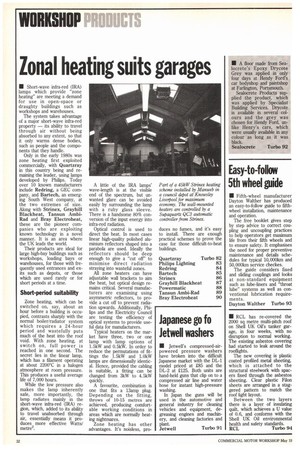Zonal heating suits garages
Page 144

If you've noticed an error in this article please click here to report it so we can fix it.
• Short-wave infra-red (IRA) lamps which provide "zone heating" are meeting a demand for use in open-space or draughty buildings such as workshops and warehouses.
The system takes advantage of a major short-wave infra-red property — its ability to travel through air without being absorbed to any extent, so that it only warms dense bodies, such as people and the components that they handle.
Only in the early 1980s was zone heating first exploited commercially, with Quartzray in this country being and remaining the leader, using lamps developed by Philips. Today over 10 known manufacturers include Redring, a GEC company, and Bartech, an emergmg South West company, at the two extremes of size. Along with Strinex, Grayhill Blackheat, Tansun AmbiRad and Bray Electroheat, these are the pioneer companies who are exploiting known technology in a novel manner. It is an area where the UK leads the world.
Their products are ideal for large high-bay buildings such as workshops, loading bays or warehouses, for those with frequently used entrances and exits such as depots, or those which are used rarely or for short periods at a time.
Short-period suitability
Zone heating, which can be switched on, say, about an hour before a building is occupied, contrasts sharply with the normal boiler/radiator system which requires a 24-hour period and wastefully puts much of the heat into the roof void. With zone heating, at switch on, full power is reached in one second. The secret lies in the linear lamp, which has a filament operating at about 2200°C in a halogen atmosphere at room pressure. This produces a useful average life of 7,000 hours.
While the low pressure also makes the lamp inherently safe, more importantly, the lamp radiates mainly in the short-wave infra-red (IRA) region, which, added to its ability to travel unabsorbed through air, essentially means it produces, more effective Watts/ metre'.
A little of the IRA lamps' wave-length is at the visible end of the spectrum, but unwanted glare can be avoided easily by surrounding the lamp with a ruby glass sleeve. There is a handsome 80% conversion of the input energy into infra-red radiation.
Optical control is used to direct the heat. In most cases linear high-quality polished aluminium reflectors shaped into a parabola are used. Ideally the reflectors should be deep enough to give a "cut off" to minimise direct radiation straying into wasteful zones.
All zone heaters can have adjustable wall brackets to aim the heat, but optical design remains critical. Several manufacturers are examining using asymmetric reflectors, to provide a cut off to prevent radiation upwards. Additionally, Philips and the Electricity Council are testing the efficiency of optical systems to provide useful data for manufacturers.
Typical heaters on the market have three, two or one lamp with lamp options of 1.5kW and 0.5kW. In order to reduce the permutations of fittings the 1.5kW and 1.0kW lamps are dimensionally identical. Hence, provided the cabling is suitable, a fitting can be changed from 3kW to 4.5kW quickly.
A favourite, combination is one that fits a 13amp plug. Depending on the fitting, throws of 10-15 metres are achieved, producing comfortable working conditions in areas which are normally heating nightmares.
Zone heating has other advantages. It's noisless, pro Part of a 45kW Strinex heating scheme installed by Mantveb in a council depot at Knowsley Liverpool for maximum economy. The wall-mounted heaters are controlled by a SuPaquartz QC3 automatic controller from Strinex.
duces no fumes, and it's easy to install. There are enough practical schemes to prove the case for those difficult-to-heat buildings.




















































































































































